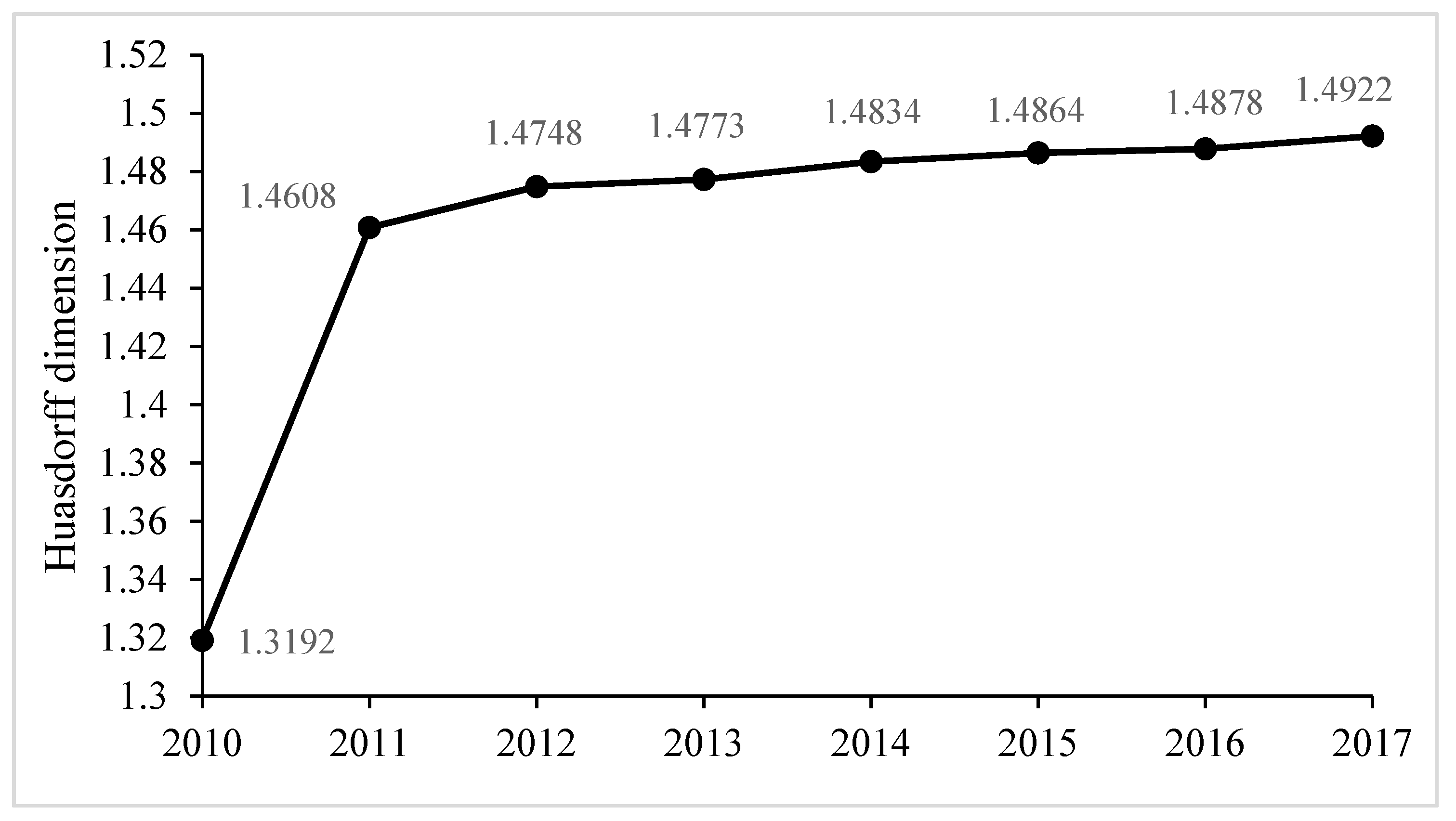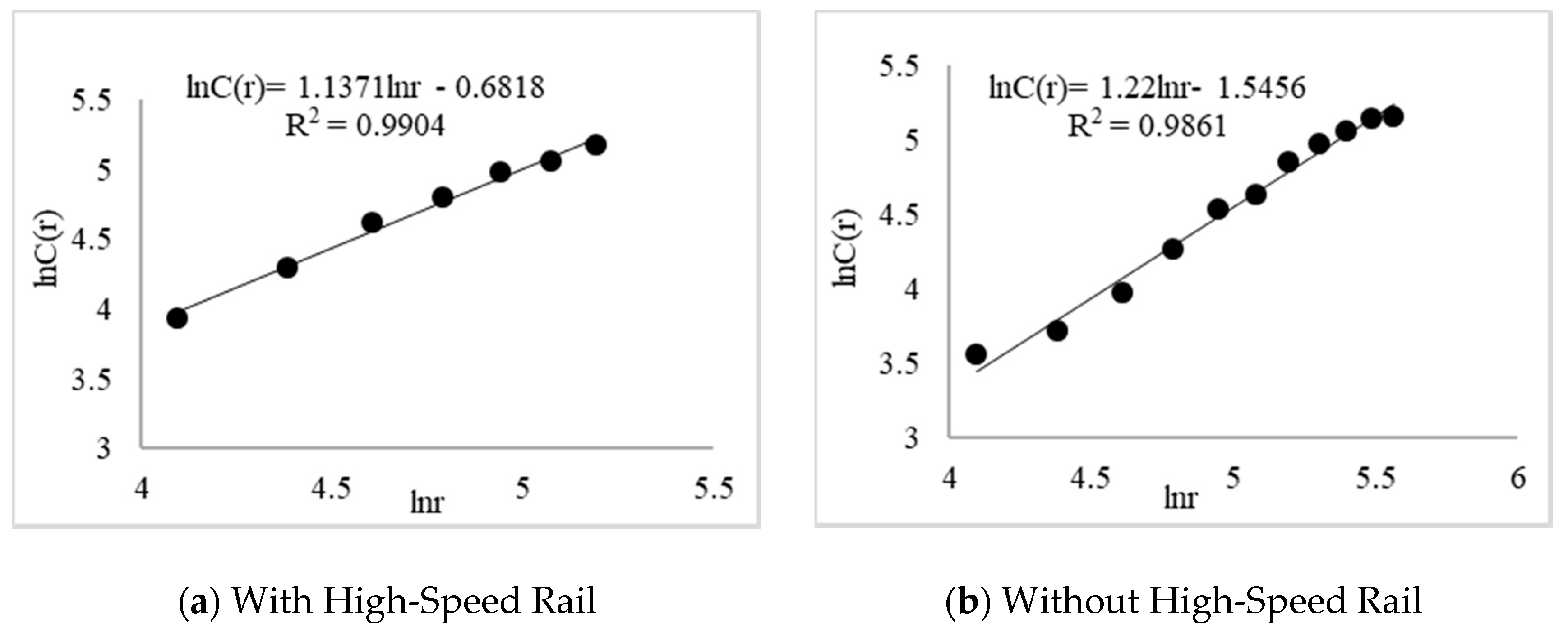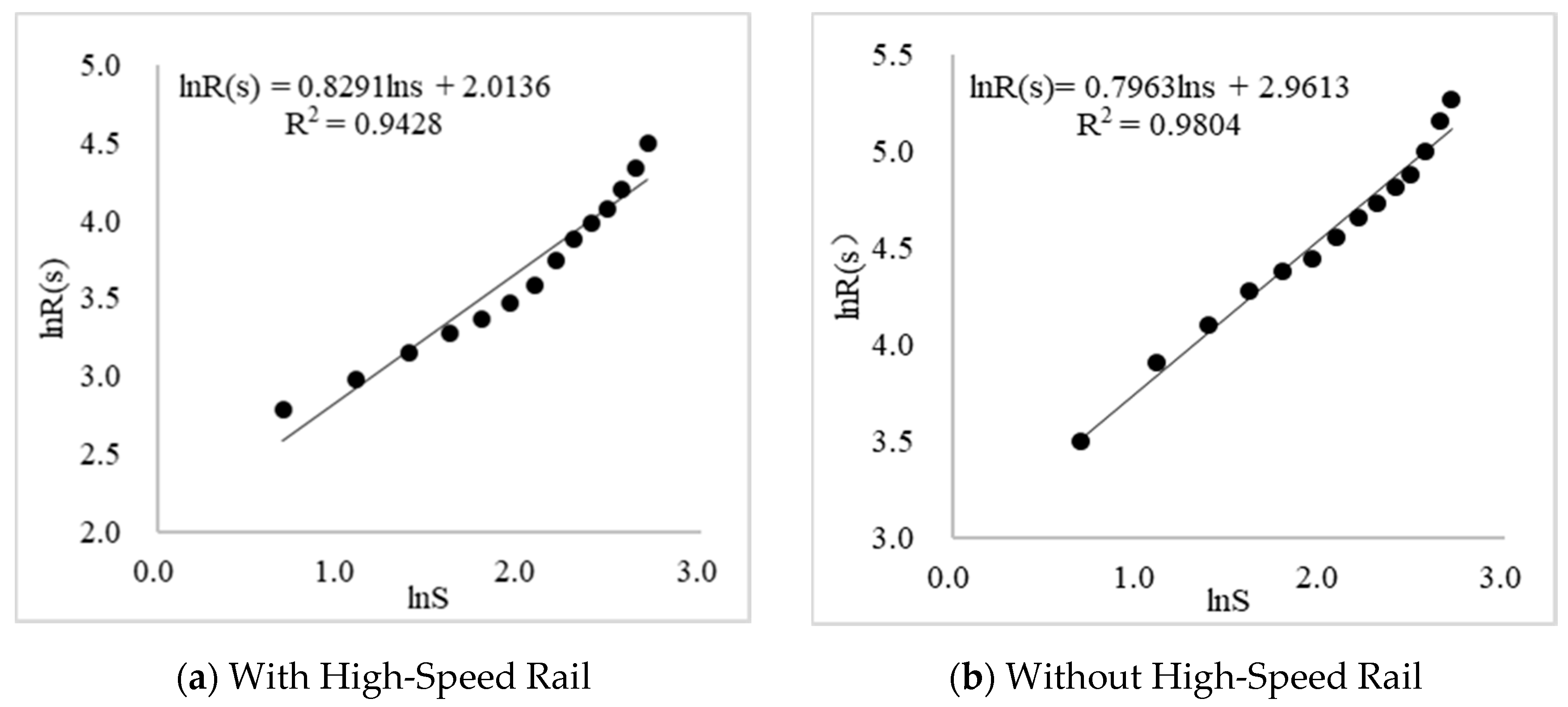Research on the Influence of a High-Speed Railway on the Spatial Structure of the Western Urban Agglomeration Based on Fractal Theory—Taking the Chengdu–Chongqing Urban Agglomeration as an Example
Abstract
:1. Introduction
2. Methods and Data
2.1. Method
2.1.1. Fractal Model of Urban Scale Sequence Structure
2.1.2. Correlation Model of Urban Spatial Structure
2.1.3. Agglomeration Model of Urban Spatial Structure
2.2. Data
3. Results
3.1. The Rank-Size Structure of Urban Agglomerations in the Western Region
3.2. The Spatial Structure of the Chengdu–Chongqing Urban Agglomeration
3.2.1. The Spatial Structure Correlation of the Chengdu–Chongqing Urban Agglomeration
3.2.2. The Agglomeration of the Spatial Structure of the Chengdu–Chongqing Urban Agglomeration
4. Conclusions and Discussion
- (1)
- Through the research on the spatial structure of the western urban agglomeration, the results show that the Hausdorff dimension of the Lan–Xi urban agglomeration and Guanzhong Plain urban agglomeration is less than 1. The primary city is in a prominent monopoly position, and the spatial structure is an unbalanced "primacy” type. For such urban agglomerations, it is suggested that the leading role of the primary city should be actively used in the construction of high-speed rail by means of "point-line-surface". Specifically, strengthening the construction of high-speed rail channels between the primary and medium-sized cities promotes the flow of the industry, population, and resources of the primary city to the medium-sized city, and then cultivate the regional secondary central city. Finally, it promotes the spatial structure of the urban agglomeration to develop toward the “rank-size” type.
- (2)
- By comparing the traffic distance matrix between the cities and the average radius of the cities with or without high-speed rail, it was found that the traffic time distance and average radius show an apparent downward trend after the opening of high-speed rail. This indicates that the opening of high-speed rail is indeed conducive to improve the internal correlation and agglomeration degree of urban agglomerations. Therefore, to promote the economic restructuring and spatial pattern reconstruction of an urban agglomeration, we should take the Chengdu–Chongqing urban agglomeration as a reference. Specifically, speeding up the construction of intercity railway networks and rapid transportation systems based on high-speed rail cities. With the convenience of high-speed rail networks, we can promote the exchange and cooperation of excellent industries between high-speed rail cities and non-high-speed rail cities, further accelerating the formation of an urban agglomeration pattern with high-speed rail as the link.
- (3)
- It was found from the development planning documents of the four urban agglomerations that different areas of the same province are divided into different urban agglomerations. This means that the linkage development among the western urban agglomerations needs to strengthen the cooperation between the urban agglomerations. The Chengdu–Chongqing high-speed railway and Xi’an–Chengdu high-speed railway connect the Chengdu–Chongqing urban agglomeration, which is the key to the National Southwest open channel strategy, and to the Guanzhong Plain Urban Agglomeration, which is the strategic hub of the Northwest Open Channel. It connects Xi’an, Chongqing, and Chengdu, which are the fastest developing cities in western China. Furthermore, it promotes the in-depth exchange of human resources, information, resources, science, and technology between Sichuan, Chongqing, and northwest China. Therefore, it is urgent to speed up the construction of a high-speed rail network in western China to promote urban agglomeration in western China.
Author Contributions
Funding
Conflicts of Interest
References
- Zhang, C.; Song, Y.; Xia, H. Urban form evolution of Beijing–Tianjin–Hebei urban agglomeration driven by high-speed railway. Beijing Plan. Rev. 2016, 4, 42–46. [Google Scholar]
- Spiekermann, K.; Wegener, M. The shrinking continent: New time-space maps of Europe. Environ. Plan. B: Plan. Des. 1994, 21, 653–673. [Google Scholar] [CrossRef]
- Blum, U.; Havens, K.E.; Karlsson, C. Introduction to the special issue, the regional and urban effects of high-speed trains. Ann. Reg. Sci. 1997, 31, 1–20. [Google Scholar] [CrossRef]
- Vickerman, R. High-speed Rail in Europe: Experience and issue for future development. Ann. Reg. Sci. 1997, 31, 21–38. [Google Scholar] [CrossRef]
- Vickerman, R.; Spiekermann, K.; Wegener, M. Accessibility and economic development in Europe. Reg. Stud. 1999, 33, 1–15. [Google Scholar] [CrossRef]
- Gutiérrez, J.; Gonzalez, R.; Gomez, G. The European high-speed train network: Predicted effects on accessibility patterns. J. Transp. Geogr. 1996, 4, 227–238. [Google Scholar] [CrossRef]
- Gutiérrez, J. Location, economic potential and daily accessibility: An analysis of the accessibility impact of the high-speed line Madrid–Barcelona–French border. J. Transp. Geogr. 2001, 9, 229–242. [Google Scholar] [CrossRef]
- Ortega, E.; López, E.; Monzón, A. Territorial cohesion impacts of high-speed rail at different planning levels. J. Transp. Geogr. 2012, 24, 130–141. [Google Scholar] [CrossRef]
- Sun, H.; Zhang, X. The influence of high-speed railway on the traffic pattern of emerging cities and the countermeasures. Transp. Enterp. Manag. 2017, 32, 4–6. [Google Scholar]
- Ma, Y.; Lu, Y.; Ke, W.; Chen, B. The influence of Pan-Asia high-speed railway construction on spatial relation between Southwest China’s frontier area and Indo-China Peninsula. Geogr. Res. 2015, 34, 825–837. [Google Scholar]
- Wang, C.; Ren, X.; Li, Y. Accessibility and linkage pattern of central cities under high speed rail network. Areal Res. Dev. 2018, 37, 54–60. [Google Scholar]
- Zhong, Y.; Huang, J.; Wen, Y. Impact of high-speed railway on spatial pattern of Chinese cities’ accessibility. Sci. Geogr. Sin. 2015, 35, 387–395. [Google Scholar]
- Feng, C.; Feng, X.; Liu, S.J. Effects of high speed railway network on the inter-provincial accessibilities in China. Prog. Geogr. 2013, 32, 1187–1194. [Google Scholar]
- Meng, D.; Chen, W.; Lu, Y. Impacts of high-speed railway on the spatial pattern of the regional accessibility in China. Areal Res. Dev. 2011, 30, 6–10. [Google Scholar]
- Zhang, L.; Zhu, C.; Cao, L. Study on influence of Shanghai-Nanjing inter-city high-speed railway on regional accessibility. Railw. Transp.Econ. 2013, 35, 82–87. [Google Scholar]
- Fang, D.; Yang, Y. Study on transportation spatial structure fractal characteristics of Yangtze River Delta City Group in high-speed rail era. Areal Res. Dev. 2013, 32, 52–56. [Google Scholar]
- Tang, Y.; Wang, C.; Zhang, S. Impact of high-speed traffic on the temporal and spatial evolution of urban forms in Shandong Province. Areal Res. Dev. 2020, 39, 71–75. [Google Scholar]
- Jiang, H.; Xu, J.; Qi, Y. The influence of Beijing-Shanghai high-speed railways on land accessibility of regional center cities. J. Geogr. Sci. 2010, 65, 1287–1298. [Google Scholar]
- Sheng, J. Research on the Relevance between Land-based High-Speed Traffic Trunk and the Rank-size Distribution of City in China. Master Dissertation, Zhejiang University, Hangzhou, China, 29 May 2016. [Google Scholar]
- Lu, P. Study on Spatial Structure Optimization of Beijing-Tianjin-Hebei Urban agglomeration. Master Dissertation, Yanshan University, Qinhuangdao, China, 30 May 2017. [Google Scholar]
- Wang, C.; Ren, X. Influences brought by high speed rail network on Beijing–Tianjin–Hebei urban agglomeration’s spatial and temporal pattern. Urban Probl. 2018, 279, 39–46. [Google Scholar]
- Zhang, H.; Lan, T.; Li, Z. Advances in fractal cities: A shift from morphology to network. J. Geo-Inf. Sci. 2020, 22, 827–841. [Google Scholar]
- Mandelbrot, B.B. How long is the coast of Britain? Statistical self-similarity and fractional dimension. Science. 1967, 156, 636–638. [Google Scholar] [CrossRef] [Green Version]
- Mandelbrot, B.B. The Fractal Geometry of Nature; W. H. Freeman and Company: New York, NY, USA, 1982. [Google Scholar]
- Chen, Y.; Chen, W. GIS and fractal studies of geographical phenomena. J. Northeast. Norm. Univ. 1998, 2, 91–96. [Google Scholar]
- West, G.B.; Brown, J.H.; Enquist, B.J. The fourth dimension of life: Fractal geometry and allometric scaling of organisms. Science 1999, 284, 1677–1679. [Google Scholar] [CrossRef] [PubMed] [Green Version]
- Batty, M.; Longley, P.A. Fractal Cities: A geometry of Form and Function; Academic Press: San Diego, CA, USA, 1994. [Google Scholar]
- Chen, Y. Fractal Urban Systems: Scaling, Symmetry, and Spatial Complexity; Science Press: Beijing, China, 2008. [Google Scholar]
- Portugali, J. Self- Organization and the City; Springer-Verlag: Berlin, Germany, 2000. [Google Scholar]
- Liu, J.; Chen, Y. Fractal dimension of spatial structure of an urban system and the methods of their determination. Geogr. Res. 1999, 18, 171–178. [Google Scholar]
- Yan, G. Measurement and optimization of urban system structure in Changchun metropolitan area based on Fractal Theory. J. Changchun Educ. Inst. 2016, 12, 41–45. [Google Scholar]
- Cui, D.; Sun, Y. A fractal-dimension-based study on optimization of spatial structure of Huzhou tourism scenic system. Sci. Geogr. Sin. 2011, 22, 337–343. [Google Scholar]
- Fang, D.; Sun, M. Research on the influence of high speed railway construction on urban spatial structure in China—a case study of cities along Beijing Guangzhou high speed railway. Reg. Econ. Rev. 2014, 3, 136–141. [Google Scholar]
- Sun, M. Study on Influence of High-speed Railway on the Spatial Structure Reconstruction and its Economic Effect in the Yangtze River Delta Region. Master Dissertation, Anhui University of Technology, Maanshan, China, 25 May 2016. [Google Scholar]
- Chen, Y.; Liu, J. Fractals and Fractal Dimensions of City-Size Distributions. Hum. Geogr. 1999, 14, 3–5. [Google Scholar]
- Shang, Z. Fractal study on spatial structure of Nanjing metropolitan area. Stat. Decis. 2009, 20, 65–67. [Google Scholar]
- Tang, B.; Luo, X.; Zheng, H.; Gu, H. Urban system spatial structure fractal research of hunan province under new-style urbanization. Mod. Urban Res. 2015, 8, 79–84. [Google Scholar]
- Liu, Z.; Zhang, Y. A Study on the central place system and fractal feature of China’s city group: The case of Hunan “3+5” city group. Mod. Urban Res. 2014, 11, 75–80. [Google Scholar]
- Shang, Z.; Zhang, X. Urban system spatial structure and its fractal characteristic of the Yangtze Delta. Econ. Geogr. 2009, 29, 913–916. [Google Scholar]






| Chengdu | Chongqing | Mianyang | Leshan | Suining | Neijiang | Nanchong | Zigong | Ziyang | Deyang | Meishan | Guang’an | Dazhou | Wanzhou | Hechuan | |
|---|---|---|---|---|---|---|---|---|---|---|---|---|---|---|---|
| Chengdu | 0 | 174 | 107 | 110 | 85 | 282 | 111 | 362 | 146 | 47 | 72 | 202 | 195 | 385 | 166 |
| Chongqing | 77 | 0 | 259 | 313 | 122 | 195 | 98 | 195 | 222 | 291 | 270 | 77 | 150 | 317 | 33 |
| Mianyang | 36 | 135 | 0 | 237 | 171 | 204 | 138 | 228 | 185 | 42 | 165 | 185 | 282 | 346 | 201 |
| Leshan | 46 | 164 | 102 | 0 | 178 | 118 | 220 | 108 | 106 | 179 | 75 | 245 | 361 | 421 | 224 |
| Suining | 56 | 70 | 148 | 131 | 0 | 101 | 43 | 125 | 103 | 137 | 150 | 84 | 136 | 451 | 80 |
| Neijiang | 40 | 42 | 94 | 121 | 107 | 0 | 136 | 46 | 68 | 164 | 128 | 150 | 284 | 331 | 137 |
| Nanchong | 88 | 69 | 126 | 175 | 34 | 144 | 0 | 170 | 139 | 172 | 186 | 85 | 81 | 396 | 62 |
| Zigong | 86 | 91 | 228 | 108 | 419 | 46 | 370 | 0 | 93 | 187 | 121 | 175 | 310 | 360 | 157 |
| Ziyang | 25 | 62 | 79 | 104 | 82 | 20 | 111 | 165 | 0 | 106 | 77 | 165 | 280 | 339 | 166 |
| Deyang | 23 | 127 | 17 | 111 | 80 | 76 | 115 | 187 | 57 | 0 | 171 | 223 | 283 | 364 | 211 |
| Meishan | 32 | 143 | 81 | 19 | 108 | 99 | 282 | 121 | 69 | 86 | 0 | 228 | 394 | 393 | 218 |
| Guang’an | 127 | 66 | 171 | 201 | 68 | 134 | 46 | 175 | 170 | 175 | 180 | 0 | 140 | 262 | 76 |
| Dazhou | 155 | 127 | 85 | 249 | 115 | 220 | 84 | 310 | 257 | 211 | 394 | 70 | 0 | 266 | 185 |
| Wanzhou | 198 | 90 | 246 | 282 | 179 | 157 | 172 | 360 | 185 | 228 | 246 | 237 | 374 | 0 | 237 |
| Hechuan | 100 | 25 | 201 | 224 | 50 | 88 | 48 | 157 | 109 | 211 | 133 | 92 | 125 | 124 | 0 |
| Number | 1 | 2 | 3 | 4 | 5 | 6 | 7 | 8 | 9 | 10 | 11 |
|---|---|---|---|---|---|---|---|---|---|---|---|
| r | 20 | 40 | 60 | 80 | 100 | 120 | 140 | 160 | 180 | 200 | 220 |
| C(r) | 21 | 35 | 51 | 73 | 101 | 121 | 145 | 157 | 177 | 183 | 193 |
| Number | 12 | 13 | 14 | 15 | 16 | 17 | 18 | 19 | 20 | 21 | |
| r | 240 | 260 | 280 | 300 | 320 | 340 | 360 | 380 | 400 | 420 | |
| C(r) | 201 | 209 | 209 | 213 | 215 | 215 | 217 | 221 | 223 | 225 |
| With High-Speed Rail | Without High-Speed Rail | ||||||
|---|---|---|---|---|---|---|---|
| City Name | Distance from Chengdu | Number of Cities | Average Radius | City Name | Distance from Chengdu | Number of Cities | Average Radius |
| ri | S | Rs | ri | S | Rs | ||
| Chengdu | 0 | 1 | 0.00 | Chengdu | 0 | 1 | 0.00 |
| Deyang | 23 | 2 | 16.26 | Deyang | 47 | 2 | 33.23 |
| Ziyang | 25 | 3 | 19.61 | Meishan | 72 | 3 | 49.64 |
| Meishan | 32 | 4 | 23.33 | Suining | 85 | 4 | 60.45 |
| Mianyang | 36 | 5 | 26.36 | Mianyang | 107 | 5 | 72.20 |
| Neijiang | 40 | 6 | 29.08 | Leshan | 110 | 6 | 79.76 |
| Leshan | 46 | 7 | 32.05 | Nanchong | 111 | 7 | 84.93 |
| Suining | 56 | 8 | 35.93 | Ziyang | 146 | 8 | 94.74 |
| Chongqing | 77 | 9 | 42.50 | Hechuan | 166 | 9 | 105.07 |
| Zigong | 86 | 10 | 48.63 | Chongqing | 174 | 10 | 113.86 |
| Nanchong | 88 | 11 | 53.42 | Dazhou | 195 | 11 | 123.46 |
| Hechuan | 100 | 12 | 58.73 | Guang’an | 202 | 12 | 131.80 |
| Guang’an | 127 | 13 | 66.52 | Neijiang | 282 | 13 | 148.84 |
| Dazhou | 155 | 14 | 76.32 | Zigong | 362 | 14 | 173.01 |
| Wanzhou | 198 | 15 | 89.72 | Wanzhou | 385 | 15 | 194.47 |
© 2020 by the authors. Licensee MDPI, Basel, Switzerland. This article is an open access article distributed under the terms and conditions of the Creative Commons Attribution (CC BY) license (http://creativecommons.org/licenses/by/4.0/).
Share and Cite
Li, J.; Qian, Y.; Zeng, J.; Yin, F.; Zhu, L.; Guang, X. Research on the Influence of a High-Speed Railway on the Spatial Structure of the Western Urban Agglomeration Based on Fractal Theory—Taking the Chengdu–Chongqing Urban Agglomeration as an Example. Sustainability 2020, 12, 7550. https://doi.org/10.3390/su12187550
Li J, Qian Y, Zeng J, Yin F, Zhu L, Guang X. Research on the Influence of a High-Speed Railway on the Spatial Structure of the Western Urban Agglomeration Based on Fractal Theory—Taking the Chengdu–Chongqing Urban Agglomeration as an Example. Sustainability. 2020; 12(18):7550. https://doi.org/10.3390/su12187550
Chicago/Turabian StyleLi, Jiao, Yongsheng Qian, Junwei Zeng, Fan Yin, Leipeng Zhu, and Xiaoping Guang. 2020. "Research on the Influence of a High-Speed Railway on the Spatial Structure of the Western Urban Agglomeration Based on Fractal Theory—Taking the Chengdu–Chongqing Urban Agglomeration as an Example" Sustainability 12, no. 18: 7550. https://doi.org/10.3390/su12187550
APA StyleLi, J., Qian, Y., Zeng, J., Yin, F., Zhu, L., & Guang, X. (2020). Research on the Influence of a High-Speed Railway on the Spatial Structure of the Western Urban Agglomeration Based on Fractal Theory—Taking the Chengdu–Chongqing Urban Agglomeration as an Example. Sustainability, 12(18), 7550. https://doi.org/10.3390/su12187550





